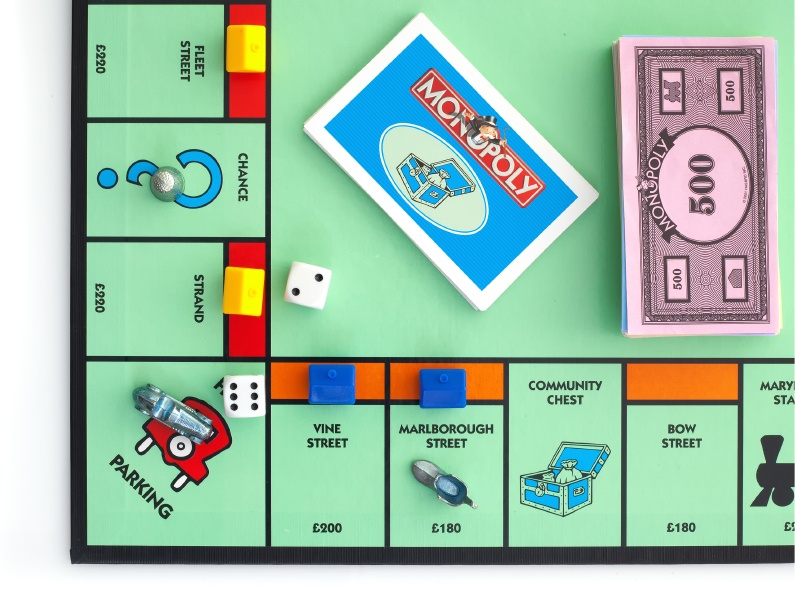Home » Uncategorised »
Playing the Property Game: Modern London vs. the Monopoly Board
This article is an external press release originally published on the Landlord News website, which has now been migrated to the Just Landlords blog.

Ah, Monopoly. Everyone’s favourite cut-throat game. Success is largely based on your initial luck, so the eventual winner can be spotted early on. Meanwhile, everyone else is left to squabble amongst themselves simply to stay afloat.
Wait, is this the board game, or the actual London property market?
The Landlord’s Game, as it was originally titled in 1903, was designed as a teaching tool to highlight the inequalities of privilege and the evils of capitalism. Yet, despite its lessons being keenly felt by everyone who has painstakingly mortgaged their properties and handed their last few bills to a wealthy neighbour, the system it’s based on is still strikingly familiar over a century later.
The only real changes? The fashionable locations have changed and rent has gone up – everywhere.
Property values
In the world of Monopoly, it only costs £200 to build a house in Mayfair. When players subsequently visit that property, rent is charged at a measly £200 – although it rises to £1,700 if all four houses have been purchased. In the real world? A house in the W1 postcode will currently set you back around £3m, while renting is going to cost about £6,000 a month.
Even “the cheapest home in Mayfair” (as it was dubbed when sold in February last year) was valued at £500,000. Bargain. If this sounds too good to be true, that’s because it was. The flat was leasehold only, with a term that had only 12 years remaining – which, let’s face it, is barely enough time to finish your first game of Monopoly. That meant that the buyer would essentially be paying £868 a week for little over a decade, after which they would be handing the keys over to the freeholder with nothing to show for it. Although… considering the rent prices mentioned above, maybe this isn’t such a bad deal after all.
This whole issue was addressed in a customised board update designed by London Fox lettings in 2017, which listed more accurate prices for all the Monopoly locations across the capital. Of course, to make this version of the game truly realistic, the bank would need to be stocked with a lot more cash… but the players wouldn’t get to see any of it.
Key locations
Prices go hand-in-hand with location. Spaces on the cheap side of the board would have been originally chosen for their undesirability, but, thanks to gentrification, most of these locations look very different today. Equally, there are places midway around the Monopoly board that have had their position usurped by up-and-coming areas.
For example, Old Kent Road is the cheapest plot of land on the board, but the real-life road runs through Southwark, where average property values are currently around £700,000. This would bump it up to somewhere in the orange section of properties. Meanwhile, somewhere like Bond Street will lose its cushy spot amongst the green tiles to Piccadilly, where house prices have soared to over £2m.
If you’re curious about other locations that might be more realistic options for a modern monopoly board, you can find the details of a fully re-vamped layout here. Imagined in 2015, it might not quite reflect current property values, but certainly sparks up some conversation and provides some inspiration if you’re thinking about taking a Sharpie to your current version.
Train stations
The stations are due for an update, too. Liverpool Street still qualifies as one of the country’s busiest train hubs, but it’s time for King’s Cross, Fenchurch and Marylebone to move over. Waterloo, Victoria and London Bridge see the most entries and exits every year, although Clapham Junction receives the highest number of interchanges (27.3m in 2016-2017).
We should probably re-consider the rent on these at the same time. Whenever a player lands on one they should be charged the cost of an annual Oyster card for zones 1-3. £1,600 sounds fair, right?
Chance cards
Chance cards are a critical element of Monopoly, acting as a beacon of hope for players that are experiencing financial difficulties. Paying £15 for a speeding fine is hardly representative of modern life though, so we’d make these changes:
- Speeding fine £100 – and take three points off of your next roll
- Advance to Mayfair and roll a dice. If it’s even, pay another player £10 for being your Uber driver. If it’s odd, pay the bank £50 for your black cab hire.
- Pay school fees of £5,700. We’re not kidding.
- Congratulations, you’ve found a fiver in your pocket! (What, they can’t all be bad!)
Free parking
Free parking? In London? Yeah, right.




